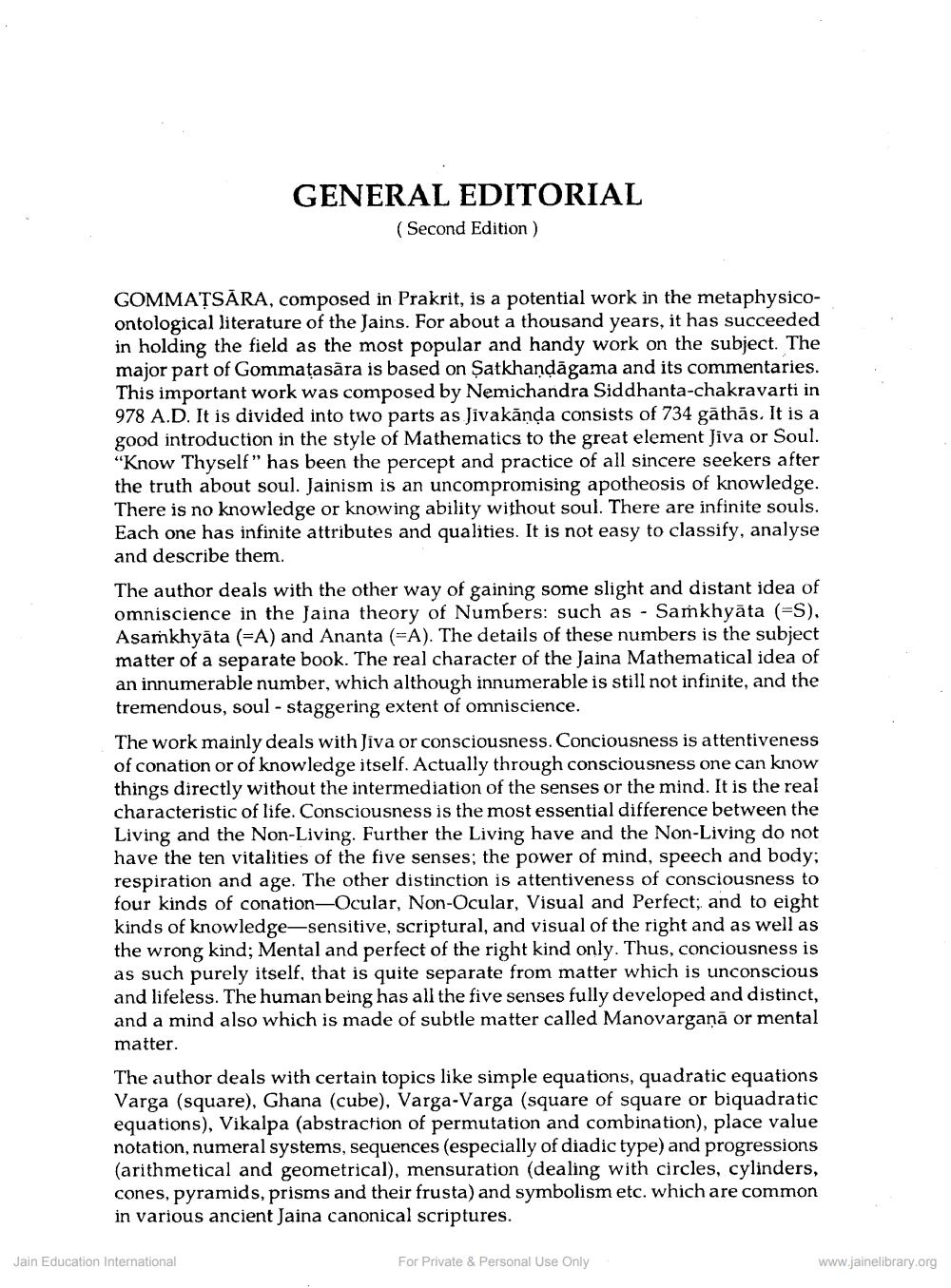Book Title: Gommatasara Jiva kanda Part 1 Author(s): Nemichandra Siddhant Chakravarti, A N Upadhye, Kailashchandra Shastri Publisher: Bharatiya Gyanpith View full book textPage 9
________________ GENERAL EDITORIAL (Second Edition) GOMMATSĀRA, composed in Prakrit, is a potential work in the metaphysicoontological literature of the Jains. For about a thousand years, it has succeeded in holding the field as the most popular and handy work on the subject. The major part of Gommațasāra is based on Satkhandāgama and its commentaries. This important work was composed by Nemichandra Siddhanta-chakravarti in 978 A.D. It is divided into two parts as Jivakānda consists of 734 gāthās. It is a good introduction in the style of Mathematics to the great element Jiva or Soul. “Know Thyself" has been the percept and practice of all sincere seekers after the truth about soul. Jainism is an uncompromising apotheosis of knowledge. There is no knowledge or knowing ability without soul. There are infinite souls. Each one has infinite attributes and qualities. It is not easy to classify, analyse and describe them. The author deals with the other way of gaining some slight and distant idea of omniscience in the Jaina theory of Numbers: such as - Samkhyāta (=S). Asamkhyäta (=A) and Ananta (=A). The details of these numbers is the subject matter of a separate book. The real character of the Jaina Mathematical idea of an innumerable number, which although innumerable is still not infinite, and the tremendous, soul - staggering extent of omniscience. The work mainly deals with Jiva or consciousness. Conciousness is attentiveness of conation or of knowledge itself. Actually through consciousness one can know things directly without the intermediation of the senses or the mind. It is the real characteristic of life. Consciousness is the most essential difference between the Living and the Non-Living. Further the Living have and the Non-Living do not have the ten vitalities of the five senses; the power of mind, speech and body; respiration and age. The other distinction is attentiveness of consciousness to four kinds of conation-Ocular, Non-Ocular, Visual and Perfect; and to eight kinds of knowledge-sensitive, scriptural, and visual of the right and as well as the wrong kind; Mental and perfect of the right kind only. Thus, conciousness is as such purely itself, that is quite separate from matter which is unconscious and lifeless. The human being has all the five senses fully developed and distinct, and a mind also which is made of subtle matter called Manovargaņā or mental matter. The author deals with certain topics like simple equations, quadratic equations Varga (square), Ghana (cube), Varga-Varga (square of square or biquadratic equations), Vikalpa (abstraction of permutation and combination), place value notation, numeral systems, sequences (especially of diadic type) and progressions (arithmetical and geometrical), mensuration (dealing with circles, cylinders, cones, pyramids, prisms and their frusta) and symbolism etc. which are common in various ancient Jaina canonical scriptures. Jain Education International For Private & Personal Use Only www.jainelibrary.orgPage Navigation
1 ... 7 8 9 10 11 12 13 14 15 16 17 18 19 20 21 22 23 24 25 26 27 28 29 30 31 32 33 34 35 36 37 38 39 40 41 42 43 44 45 46 47 48 49 50 51 52 53 54 55 56 57 58 59 60 61 62 63 64 65 66 67 68 69 70 71 72 73 74 75 76 77 78 79 80 81 82 83 84 85 86 87 88 89 90 91 92 ... 564
